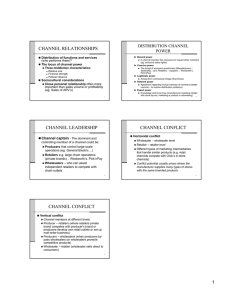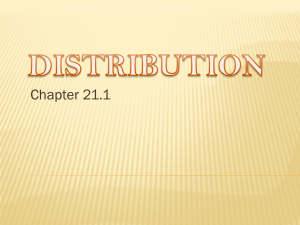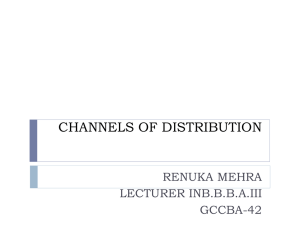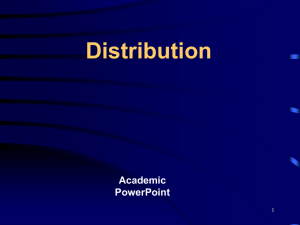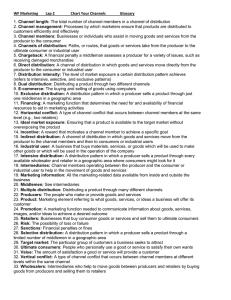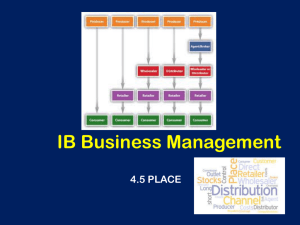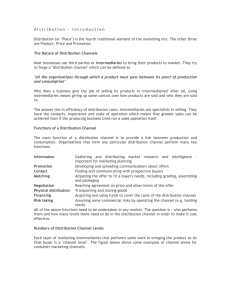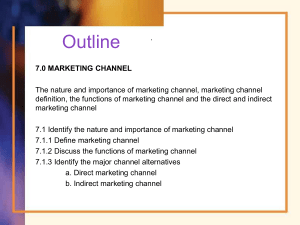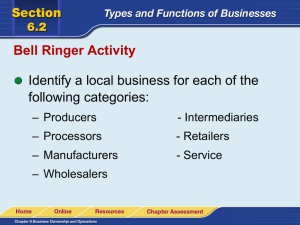Marketing 3.05 Acquire foundational knowledge of channel
advertisement
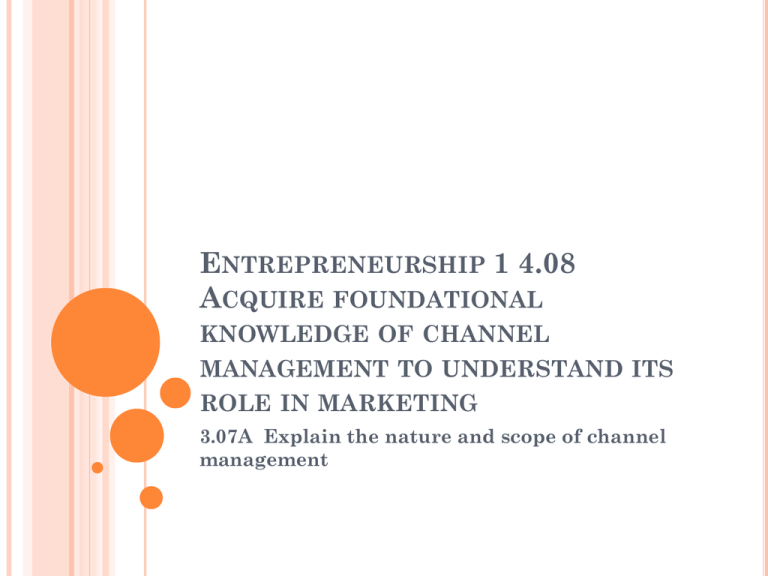
ENTREPRENEURSHIP 1 4.08 ACQUIRE FOUNDATIONAL KNOWLEDGE OF CHANNEL MANAGEMENT TO UNDERSTAND ITS ROLE IN MARKETING 3.07A Explain the nature and scope of channel management WHAT IS A… Channel: A path through which goods and services flow in one direction (from vendor to the consumer), and the payments generated by them that flow in the opposite direction (from consumer to the vendor). Channel length is the total number of channel members in a channel of distribution Exclusive distribution is a distribution pattern in which a producer sells a product through just one middle man in a geographic area WHAT IS… Selective distribution is where a producer sells a product through a limited number of middlemen in a geographic area (Target or Mass?) Intensive distribution is where a producer sells a product through every available wholesaler and retailer in a geographic area where consumers might look for it (Target or Mass) Channel members are business or individuals who assist in moving goods and services from the producer to the consumer CHANNEL FUNCTIONS Providing marketing information: Companies rely on market research to determine their target markets’ needs and wants Ex: small business producing handmade greeting cards Promoting products: Can be expensive Retailers often take a large portion of promotion responsibilities Ex: local supermarkets/discount stores CHANNEL FUNCTIONS Negotiating with the customers: Different prices are paid by the wholesaler, retailer and consumers based on negotiation Physical distribution Financing and risk taking: Moving products through a channel costs money When channel members work together to finance activities and to assume financial risks, channels will be more effective EXPLAIN KEY CHANNEL TASKS Providing marketing information Promoting products Rely on market research to determine their target markets’ needs and wants Costs and responsibilities can be shared Negotiating with customers Offering to deliver and install products EXPLAIN KEY CHANNEL TASKS Reducing discrepancies Selling large quantities of products to wholesalers and retailers Financing and risk-taking Work together to finance activities to become more effective WHEN A CHANNEL IS MOST EFFECTIVE The channel must be properly managed Recognize the importance of their task and make informed decisions Channel members share a common goal Commitment to quality of the product Satisfying the target market’s needs and wants Channel members must share tasks Tasks should be assigned to the members who can perform them best HORIZONTAL AND VERTICAL CONFLICT Horizontal Conflict: occurs between channel members at the same level Good, old-fashioned business competition Ex: two retailers selling pet supplies compete to sell to the same target market(PetSmart and Pet Supermarket) Vertical Conflict: occurs between channel members at different levels within the same channel Producers and wholesalers or producers and retailers (West Produce and Sams Club) (Stewarts Produce and IGA) CHANNEL MANAGEMENT DECISIONS Setting channel objectives Determine what the company is trying to achieve Meet the needs and wants of their target market Give their product a competitive edge Indirect distribution: middlemen Direct distribution: dealing with the final consumers directly CHANNEL MANAGEMENT DECISIONS Determining distribution patterns Achieve ideal market exposure (make their product available without over exposing and losing money) To achieve market exposure, marketers must determine distribution intensity Intensive distribution: selling a product through every available wholesaler and retailer in a geographic area where consumers might look for it Used when trying to reach the greatest number of customers possible (ex: convenience items – gum) (mass marketing – light bulbs) CHANNEL MANAGEMENT DECISIONS Selective distribution: selling a product through limited number of wholesalers and retailers in a geographic area (high-end clothing manufacturers) (target marketing) Exclusive distribution: selling a product through one middleman in a geographic area. Used to maintain tight control over a product. (specialty products – airplanes, large machinery) CHANNEL MANAGEMENT DECISIONS Selecting channel members Determine the types of members the belong in the channel, as well as the channel length (total number of channel members) Usually based on the nature of the product (perishable vs non pershible) Factors to consider: Create product value that others cannot or are not willing to provide Channel the product to its desired market Have a pricing and promotion strategy compatible with the product’s needs Offer customer service compatible with the products needs Be willing and able to work cooperatively with other members within the product’s channel CHANNEL MANAGEMENT DECISIONS CONT’ Determining channel responsibilities Members must work together appropriately and perform the tasks they are best suited for Managing, motivating, and monitoring channel members Marketers should constantly evaluate the channel What is working? What is not working? What can be improved? CHANNEL MANAGEMENT DECISIONS CONT’ Motivation can be positive or negative Sanctions may be imposed on middlemen not performing well Chargebacks – financial penalties assessed for a variety of problems Incentives may be offered for reaching performance goals CHANNEL DESIGN DECISIONS Analyzing customer needs Setting channel objectives Identifying major alternatives Types of intermediaries Number of intermediaries Responsibilities of intermediaries HOW CHANNEL MEMBERS ADD VALUE Every channel member should add value to the product as it moves through the channel Adding value to the product benefits all channel members Being able to perform one or more activities needed to get the product to the final consumer Ex: Retailers may create exciting visual displays in their stores to promote a product By performing this task, retailers can add value to the product and benefit every member in the channel. RELATIONSHIP BETWEEN PRODUCT DISTRIBUTION AND DISTRIBUTION PATTERNS
